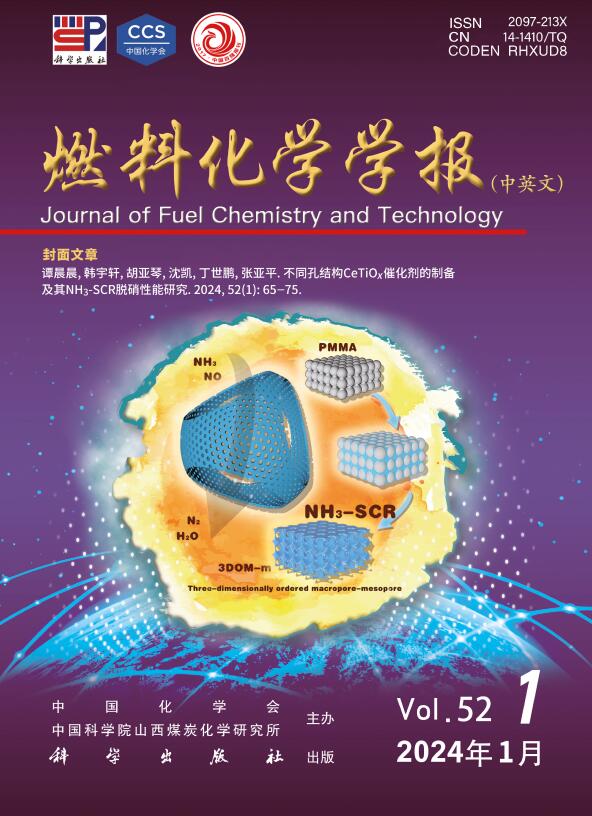Study on the regulation of Fischer-Tropsch synthesis catalytic performance by mixing oxides with iron-based catalysts
Q3 Energy
引用次数: 0
Abstract
In Fischer-Tropsch synthesis (FTS), iron-based catalysts are prone to deactivation due to carbon deposition. To address this challenge, we developed a simple physical powder-mixing strategy by mechanically mixing iron-based FTS catalysts with oxides such as SiO2, MgO, ZnO, ZrO2, MnO2, Al2O3, and graphene oxide (GO). Experimental results demonstrate that oxide incorporation significantly suppresses carbon deposition in a composition-dependent manner, thereby enhancing catalytic stability. Notably, after mixing with SiO2 or MgO powder, the CO conversion reached 96.6% and 97.6%, respectively, maintaining stability for more than 20 h. In contrast, catalyst mixed with quartz sand particles underwent rapid deactivation within 20, with a decrease in CO conversion from 93.0% to 14.6%, accompanied by a sharp rise in CH4 selectivity. By combining various characterization methods such as XRD, Mossbauer spectroscopy, TGA, XPS and CO-TPD, the promoting mechanism of oxides on reaction stability was deeply studied. The results indicate that the catalyst mixed SiO2 powder reduced the content of active χ-Fe5C2 phases from 97% to 52.1% and effectively suppressed carbon deposition. This enhancement is attributed to the strong interfacial interactions between SiO2 and the iron-based catalyst, which moderately inhibited CO adsorption and dissociation kinetics, decelerated carbonization, and prevented rapid accumulation of carbon species on the catalyst surface. Similar mechanisms were observed over MgO additives, further validating the role of oxide-iron interactions. This work elucidates the mechanism of the interaction between iron-based catalysts and mixed oxides on carbon deposition behavior in Fischer-Tropsch synthesis reactions, providing an innovative strategy and theoretical foundation for designing highly active and stable catalysts.
铁基催化剂与氧化物混合对费托合成催化性能的调控研究
在费托合成(FTS)中,铁基催化剂容易因碳沉积而失活。为了解决这一挑战,我们开发了一种简单的物理粉末混合策略,通过机械混合铁基FTS催化剂与氧化物,如SiO2、MgO、ZnO、ZrO2、MnO2、Al2O3和氧化石墨烯(GO)。实验结果表明,氧化物掺入显著抑制碳沉积的组成依赖的方式,从而提高催化稳定性。值得注意的是,与SiO2或MgO粉混合后,CO转化率分别达到96.6%和97.6%,并在20 h以上保持稳定。相比之下,与石英砂颗粒混合后的催化剂在20 h内快速失活,CO转化率从93.0%下降到14.6%,同时CH4选择性急剧上升。结合XRD、穆斯堡尔光谱、TGA、XPS、CO-TPD等多种表征方法,深入研究了氧化物对反应稳定性的促进机理。结果表明:混合SiO2粉末催化剂使活性χ-Fe5C2相的含量从97%降低到52.1%,有效抑制了碳沉积;这种增强归因于SiO2与铁基催化剂之间强烈的界面相互作用,适度抑制了CO的吸附和解离动力学,减缓了碳化,阻止了碳种在催化剂表面的快速积累。在MgO添加剂中观察到类似的机制,进一步验证了氧化物-铁相互作用的作用。本研究阐明了铁基催化剂与混合氧化物相互作用对费托合成反应中碳沉积行为的影响机理,为设计高活性、稳定的催化剂提供了创新策略和理论基础。
本文章由计算机程序翻译,如有差异,请以英文原文为准。
求助全文
约1分钟内获得全文
求助全文
来源期刊

燃料化学学报
Chemical Engineering-Chemical Engineering (all)
CiteScore
2.80
自引率
0.00%
发文量
5825
期刊介绍:
Journal of Fuel Chemistry and Technology (Ranliao Huaxue Xuebao) is a Chinese Academy of Sciences(CAS) journal started in 1956, sponsored by the Chinese Chemical Society and the Institute of Coal Chemistry, Chinese Academy of Sciences(CAS). The journal is published bimonthly by Science Press in China and widely distributed in about 20 countries. Journal of Fuel Chemistry and Technology publishes reports of both basic and applied research in the chemistry and chemical engineering of many energy sources, including that involved in the nature, processing and utilization of coal, petroleum, oil shale, natural gas, biomass and synfuels, as well as related subjects of increasing interest such as C1 chemistry, pollutions control and new catalytic materials. Types of publications include original research articles, short communications, research notes and reviews. Both domestic and international contributors are welcome. Manuscripts written in Chinese or English will be accepted. Additional English titles, abstracts and key words should be included in Chinese manuscripts. All manuscripts are subject to critical review by the editorial committee, which is composed of about 10 foreign and 50 Chinese experts in fuel science. Journal of Fuel Chemistry and Technology has been a source of primary research work in fuel chemistry as a Chinese core scientific periodical.
 求助内容:
求助内容: 应助结果提醒方式:
应助结果提醒方式:


